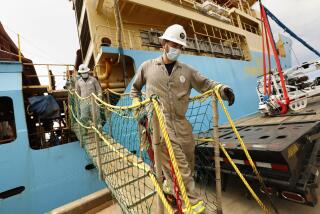Oceans Are in a World of Trouble
- Share via
This summer, 180 million Americans will travel to the seashore. Most go to relax. Many will dine on the local residents: crabs, oysters, fish, shrimp. But few are aware that the ocean is in deep trouble. Fewer still are aware that trouble for the ocean means trouble for us.
A new study published in Nature magazine underscores just how bad things are. It finds that only 10% of previous stocks of large, predatory fish -- tuna, swordfish, marlin, cod, halibut, skates and flounder -- survive in the seas. Fully 75% of all commercial fish populations are fished to capacity, are approaching collapse or have already collapsed.
The ocean is the cornerstone of our life-support system. Without it, Earth would be as inhospitable as Mars. The ocean holds 97% of Earth’s water, drives climate and weather, shapes planetary chemistry, generates more than 70% of the oxygen in the atmosphere, absorbs carbon dioxide and replenishes our fresh water through clouds.
The ocean is home for most life on Earth. By continuously processing chemicals, water and minerals, its living creatures shape the way the world works. Yet there is a widespread view that fish and other marine life are limitless commodities.
We are altering the nature of the ocean by what we put in and by what we take out. Tons of toxic substances flowing from the land have altered the ocean’s chemistry. More than 50 “dead zones” blight coastal areas. Gigantic swaths of toxic algae are fueled by high levels of nitrates and phosphates in runoff from over-fertilized fields, farms and lawns. Coral reefs, the “rain forests of the sea,” have declined about 30% in 30 years, largely because of overfishing, coastal development and global warming. Mercury levels are so high in some top-of-the-food-chain predators such as swordfish, sharks and tuna that people are advised to strictly limit their consumption. Swimmers, surfers and sunbathers are finding many of their favorite beaches contaminated -- and closed.
But there is reason for hope. The long-awaited reports from the Pew Ocean Commission and the National Ocean Commission soon will help focus this nation’s attention on the state of the seas. Internationally, scientists, industry leaders, economists, policymakers and conservation leaders from more than 20 countries will meet at the end of May in Mexico. Sponsored primarily by the Gordon and Betty Moore Foundation, the gathering is called Defying Ocean’s End. It marks the first time that these different sectors will work together to develop a specific action plan -- and identify what it will cost.
The destruction of the ocean is market-driven, and people drive the market.
Clearly, protecting large and critical parts of the ocean from commercial taking of wild fish and other marine life will be essential. There is ample evidence that marine reserves are not only good for the fish but also for fishermen as healthy populations of marine life “spill over” into adjacent waters.
The establishment of marine parks and sanctuaries is among actions being taken to forestall loss of species and habitats, but this is far from adequate. Considerably less than 1% of the ocean worldwide enjoys protection. In California, there are 220,000 square miles of combined state and federal coastal ocean; only a tiny fraction of that is set aside as off-limits to fishing.
The average person may wonder what one person can do. First and foremost, we must change common perceptions of the ocean. Knowledge is the most important first step toward understanding that there are limits to what we can do to the world around us without jeopardizing our own survival and well-being.






